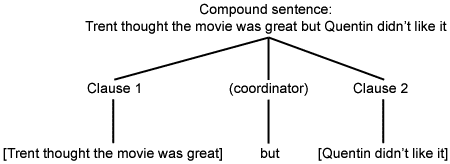Coordination
Coordination of clauses involves two (or more) clauses joined with a coordinator; and, or or but (for example, Trent thought the movie was great but Quentin didn't like it). In some cases clauses can be strung together without an intervening coordinator; this is known as apposition (for example, Emilia saw the emus, Nadine saw the pelicans, Georgia saw the snakes).
The clauses which are joined by coordination have the same status; they are each independent (main) clauses.
Contents1. Basic facts about coordination Related pages |
Basic facts about coordination
Coordination joins two (or more) independent clauses, usually with a coordinator; or, and or but (for example, We could go to the movies or see a show). As we noted above, in some cases clauses can be strung together without an intervening coordinator; this is known as apposition (for example, We had a wonderful meal, we danced until dawn, we slept all day).
A sentence which has conjoined clauses is called a compound sentence. It can be represented in a diagram as follows:

Coordination may also be used to link constituents within the clause provided they have the same status as each other. This applies to individual words (such as the nouns and the adverbs in the clause Juice and water can be drunk together or apart) and to phrases (for example the prepositional phrases in the clause We like to swim in the pool and at the beach).
Many expressions involving coordination of words have fossilized (for example betwixt and between or to and fro) while many conventional pairs are now referred to in a fixed order. Examples include cup and saucer, if and when, salt and pepper.
Layered coordination
Coordination can be recursive within a sentence or clause. This happens when a phrase or clause containing coordinated constituents is itself coordinated. This always is possible provided two constituents are of the same type.
Shall we [go in the car] or [[find our hats] and [walk there]]?
One or both coordinated constituents may contain coordination.
[[Amy or Jill] and [Jonah or Michael]] will be the School Captains next year.
Layered coordination is easiest to identify when different coordinators are used at each level, as in the preceding example. Even in this case, it is possible to have more than one reading:
[Amy or [Jill and Jonah] or Michael] will be the School Captains next year.
Joint coordination
Phrase level coordination can be interpreted in two ways. Either the coordinated elements are treated equally and distinctly (called 'distributive coordination') or they are treated jointly (joint coordination). In joint coordination the clause applies to the two elements together but does not apply to each element alone. Consider the following examples:
Joint coordination: Sally and Matt make a great team.
Distributive coordination: Sally and Matt make excellent cakes.
Note that in order to test for distributive coordination the modifier each can be used. This is not acceptable in joint coordination.
Joint coordination: ?Sally and Matt each make a great team.
Distributive coordination: Sally and Matt each make excellent cakes.
Ellipsis in coordination
Although both coordinated elements must be of the same type, they may not appear to be identical. This is because it is possible to omit material that would be repetitive. Omission of repetitive material is known as ellipsis. Compare the feel of the following two examples:
We will bake cakes in the first cooking class and prepare a stew in the second ____.
We will bake cakes in the first cooking class and prepare a stew in the second cooking class.
In addition, it is possible to coordinate sequences that are not simple constituents. Notice how, in the following examples, the coordinated sequences contain similar types of sequences (two prepositional phrases in the first example and two noun phrases (an indirect and a direct object) in the second).
We have Christmas in Melbourne in even years and ____ in Brisbane in odd years.
I gave Mary a chocolate and ____ Hugh a toy car.

